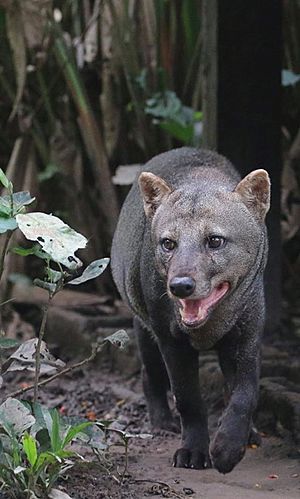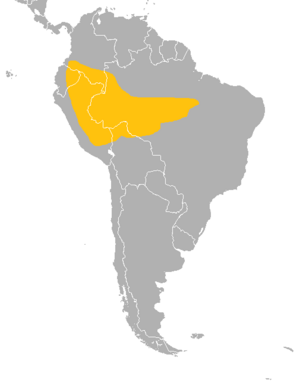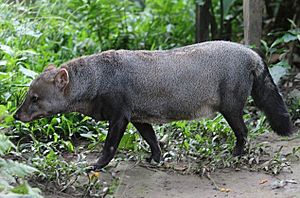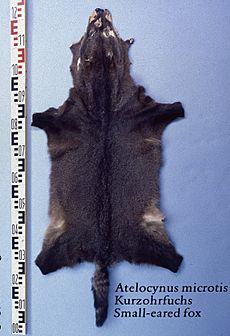Short-eared dog facts for kids
Quick facts for kids Short-eared dog |
|
|---|---|
 |
|
| Conservation status | |
| Scientific classification | |
| Genus: |
Atelocynus
|
| Species: |
microtis
|
| Subspecies | |
|
|
 |
|
| Short-eared dog range | |
The short-eared dog (Atelocynus microtis) is a special and hard-to-spot wild dog. It is also known as the short-eared zorro or small-eared dog. This animal lives only in the Amazon rainforest area. It is the only species in its group, called Atelocynus.
Contents
Other names for the Short-Eared Dog
This amazing dog has many names in the local languages where it lives.
- In Portuguese, people call it cachorro-do-mato-de-orelha-curta.
- In Spanish, it is known as zorro de oreja corta, which means "short-ear fox".
- Other names include nomensarixi in Chiquitano and uálaca in Yucuna.
- It's also called cuachi yaguar in Guarayu and quinamco in Mooré.
- In Ninam and Mosetén, it's called achuj.
Some other common Spanish names are zorro ojizarco ("blue-eyed fox"), zorro sabanero ("savannah fox"), and zorro negro ("black fox").
Where the Short-Eared Dog Lives
You can find the short-eared dog in the Amazon rainforest of South America. This includes countries like Brazil, Bolivia, Peru, Colombia, and Ecuador. It might also live in Venezuela.
There was one sighting in Panama in 1984. This is possible because the forest habitat stretches continuously into that region. This dog likes to live in parts of the rainforest where there are not many people. It lives in lowland forests and also in swampy areas. It can also be found in bamboo forests and cloud forests. It usually lives alone and prefers to move through trees, staying away from humans and other animals.
What the Short-Eared Dog Looks Like
The short-eared dog has short, thin legs and small, round ears. It has a snout that looks a bit like a fox's and a bushy tail. Its paws are partly webbed. This helps it move around in its watery home.
Its fur can be dark to reddish-grey. It can also be almost navy blue, coffee brown, dark grey, or black. The fur is short, thick, and bristly. Its chest is a bit narrow. The fur color changes from dark on its back to brighter, more reddish colors on its belly.
What the Short-Eared Dog Eats
This wild dog mostly eats meat. Its main foods are fish, insects, and small mammals. Scientists studied what these dogs eat in Peru. They found that their diet includes:
- Fish (28%)
- Insects (17%)
- Small mammals (13%)
- Various fruits (10%)
- Birds (10%)
- Crabs (10%)
- Frogs (4%)
- Reptiles (3%)
Reproduction and Behavior
The short-eared dog has some unique behaviors. Female dogs are about one-third larger than males. When excited, male dogs release a scent from glands in their tails. This helps them communicate.
This dog prefers to live alone in forest areas. It tries to avoid humans in its natural home. If a male dog feels threatened, the hairs on its back will stand up.
We don't know how long short-eared dogs live or how long their babies stay in the mother's womb. However, they become adults and can have their own babies when they are three years old. This is a bit later than other types of wild dogs.
Threats to the Short-Eared Dog
Feral dogs are a big danger to the short-eared dog. Feral dogs are wild dogs that used to be pets. They can spread diseases like canine distemper and rabies to the short-eared dog population.
The short-eared dog also suffers a lot from losing its home. People are disturbing forests that used to be quiet and remote. Human settlers and people looking for resources often destroy or expose the dens of these dogs. Humans also harm them by damaging their natural habitat and destroying the tropical rainforests where they live.
Conservation Status
The short-eared dog is currently listed as "near threatened" by the IUCN. This means it could become endangered in the future if we don't protect it. Not much research has been done on this species. We need to learn more about its habits and genes to help protect it better.
See also
 In Spanish: Zorro de orejas cortas para niños
In Spanish: Zorro de orejas cortas para niños






